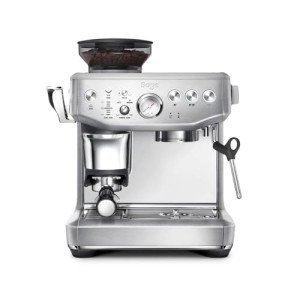The Art of Italian Espresso Machines: A Brewed Tradition
Italian espresso machines are not just home appliances; they are an integral part of Italy's rich coffee culture, representing a blend of artistry, engineering, and style. Coffee enthusiasts worldwide recognize the significance of high-quality espresso, a staple of Italian life and food. This short article checks out the history, mechanics, types, and elements to think about when buying an Italian espresso machine, reflecting the depth of this beloved drink and its developing methods.
History of Espresso Machines
The espresso machine's advancement go back to the early 20th century in Italy, where coffee was not merely a beverage however a necessary social ritual. see this page to brew espresso started with basic, stove-top models, gradually progressing into intricate machines that could reproduce the perfect brew.
- 1901-- The First Espresso Machine: The first steam-powered espresso machine, referred to as the "Ideale," was established by Luigi Bezzera. This machinery marked a turning point in espresso developing.
- 1938-- The Lever Machine: The intro of the lever machine made it much easier to manage the pressure utilized in espresso extraction, enhancing flavor consistency.
- 1947-- The Automatic Machine: Reaching more customers, Gaggia introduced the very first automatic espresso machine, further promoting espresso bars.
- 2007-- The Digital Age: Technological advancements caused the birth of totally programmable machines, enabling users to customize their brewing settings to achieve a personalized coffee experience.
Key Features of Italian Espresso Machines
Italian espresso machines embody accuracy, workmanship, and innovation. Here are some essential elements that highlight their significance:
| Feature | Description |
|---|---|
| Boiler Type | Determines how heat is produced and maintained. Typical types include single boiler, dual boiler, and heat exchanger. |
| Group Heads | Where the coffee is brewed; commercial machines frequently have several group heads for performance. |
| Pressure Control | Essential for achieving the perfect espresso; most machines run at 9 bars of pressure. |
| Frothing Capabilities | The steam wand permits for milk frothing, necessary for drinks like cappuccino and latte. |
| Construct Quality | The materials utilized (stainless-steel, brass, etc) impact resilience and heat retention. |
Kinds Of Italian Espresso Machines
Choosing the ideal machine hinges on user preferences, budget, and meant use. Below are the primary types of Italian espresso machines:
Manual Espresso Machines
- Pros: Offer complete control over the developing process, enabling for a tailored touch.
- Cons: Require ability and practice, can be labor-intensive.
Semi-Automatic Machines
- Pros: Provide a balance in between automated and manual processes; users control water circulation.
- Cons: Can have a steeper learning curve than completely automatic machines.
Completely Automatic Machines
- Pros: Simplify the developing process with push-button operations; ideal for beginners.
- Cons: May sacrifice some of the subtleties of manual brewing.
Super-Automatic Machines
- Pros: Grind, tamp, brew, and froth instantly; practical for busy way of lives.
- Cons: Less control over the brewing variables, potential for a less authentic espresso experience.
Buying Guide: Factors to Consider
Selecting the ideal Italian espresso machine can be difficult, but considering the following factors can simplify the decision-making process:
- Budget: Italian espresso machines range from affordable to high-end models, so set a budget upfront.
- Usage Frequency: Evaluate how often you will use the machine; daily users might desire a more durable option.
- Space: Measure your kitchen or counter area; some machines can be big and require sufficient clearance.
- Maintenance: Consider ease of cleansing; machines with removable parts or built-in cleaning functions might lower maintenance.
- User Skill Level: Beginners might prefer totally or semi-automatic machines, while experienced baristas can deal with manual machines.
- Brand name Reputation: Research brand names known for quality, such as Breville, Gaggia, and La Marzocco.
Popular Italian Espresso Machine Brands
Italian workmanship is renowned for producing some of the best espresso machines worldwide. Here are top brand names worth thinking about:
- Gaggia: Known for its home espresso machines and price.
- La Marzocco: An exceptional brand name understood for its commercial-grade machines and ingenious innovation.
- Rancilio: Renowned for its resilient develop and professional-quality machines suitable for home and commercial use.
- Sage/Breville: Offers advanced functions and easy to use styles, ideal for both beginners and enthusiasts.
FAQs
What is the distinction in between espresso and regular coffee?
Espresso is a focused coffee brewed by forcing warm water through finely-ground coffee under pressure. It has a thicker consistency, richer taste, and higher caffeine concentration than regular coffee.
Can I make milk-based beverages with an espresso machine?
Yes, numerous Italian espresso machines feature a steam wand to froth milk for beverages like cappuccinos, lattes, and macchiatos.
How often should I clean my espresso machine?
Routine maintenance is necessary. Normally, a thorough cleansing is advised every few weeks, while descaling ought to be done every 1 to 3 months, depending on water solidity.
What is the ideal pressure for brewing espresso?
The ideal pressure for developing espresso is around 9 bars. This pressure ensures the optimum extraction of tastes from the coffee premises.
Are more costly machines worth the financial investment?
Higher-end machines often make use of better materials and technology, supplying enhanced sturdiness and more consistent outcomes. For severe coffee lovers, buying a great machine can raise the espresso experience substantially.
Italian espresso machines are far more than mere developing gadgets; they are a celebration of a cultural custom that has influenced coffee intake worldwide. With different designs available to fit any user's requirements-- varying from beginners to experienced baristas-- there is an Italian espresso machine perfectly matched for everybody. As you start your espresso journey, understanding the history, mechanics, and options will improve your experience and gratitude for this time-honored beverage. Whether you seek to recreate a coffee shop ambiance at home or fine-tune your brewing technique, these machines can delivering memorable cups of espresso embellished with the rich history of Italian coffee culture.

